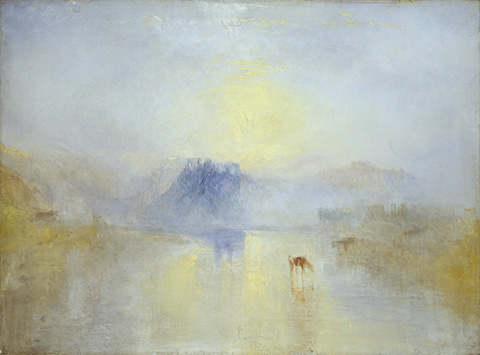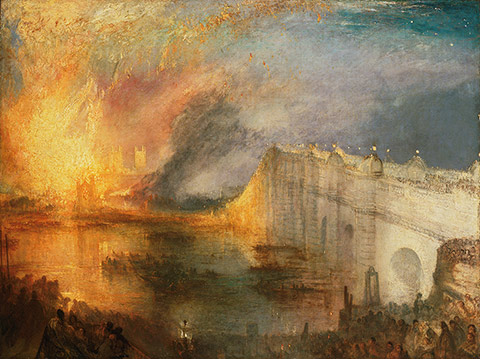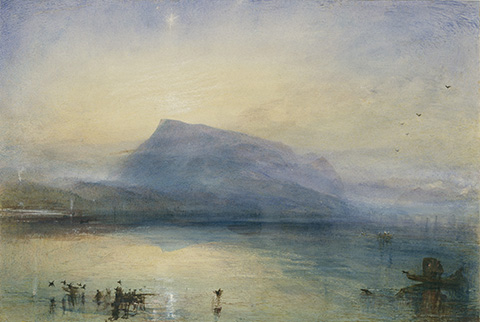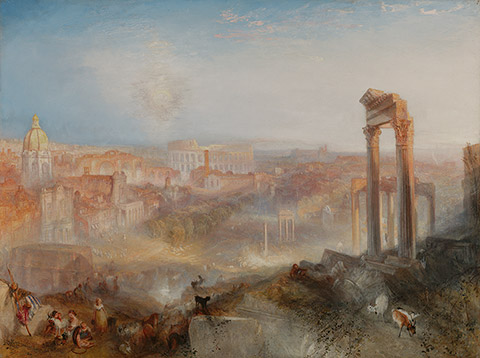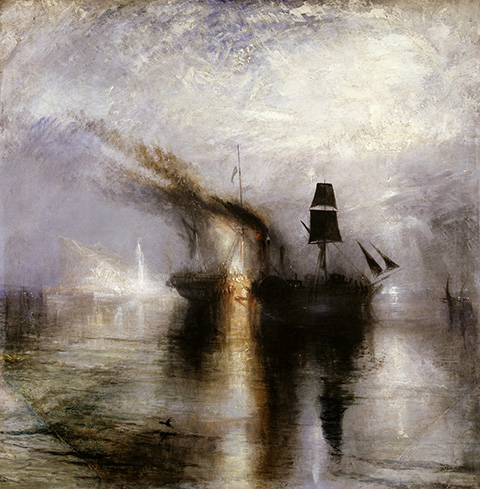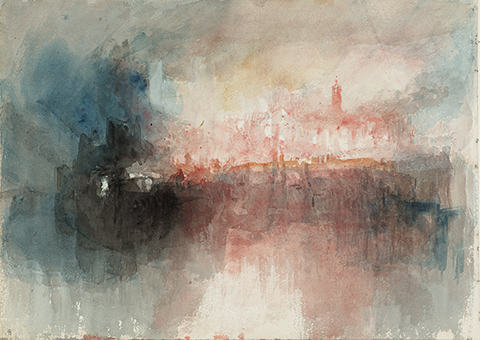During his lifetime and well before John Ruskin’s defense in Modern Painters, J. M. W. Turner was the most celebrated landscape painter in Europe, admired as much for his historical landscapes as for his arresting naturalism. In this talk, Patrick Noon of the Minneapolis Institute of the Arts examines Turner’s status and influence among the major Romantic landscape painters in England and France.
Sunday, March 1, 3:00 p.m.
Getty Center: Harold M. Williams Auditorium
Learn more about this program
J. M. W. Turner: Painting Set Free
February 24–May 24, 2015Getty Center
The first major exhibition on the West Coast devoted to the masterful British painter
Extraordinarily inventive and enduringly influential, J. M. W. Turner (1775–1851) produced many of his most important and famous pictures after the age of sixty, in the last fifteen years of his life. Demonstrating ongoing radicalism of technique and ever-original subject matter, these works show Turner constantly challenging his contemporaries while remaining keenly aware of the market for his art.
Bringing together over sixty key oil paintings and watercolors, this major international loan exhibition is the first to focus on the unfettered creativity of Turner's final years.
The exhibition was organized by Tate Britain in association with the J. Paul Getty Museum and the Fine Arts Museums of San Francisco. It is supported by an indemnity from the Federal Council on the Arts and Humanities.
See more
Related Events
All events are free, unless otherwise noted. Seating reservations are required. For reservations and information, please call (310) 440-7300 or see information on planning a visit.
Talks
J. M. W. Turner and “the finest poetic descriptions”
Does Artistic Greatness Only Come with Age?
Creative men and women often produce their greatest work after middle age. Is experience—in life, in art, in love, and loss—necessary to create works that stand the test of time? Or is age merely a number when it comes to creativity? This panel, presented with Zócalo Public Square, explores the relationship between age and artistic greatness.
Tuesday, March 24, 7:00 p.m.
Getty Center: Harold M. Williams Auditorium
Learn more about this program
Sonnets and Sonatas presents Swan Song: On Late Style
To what extent are late works significant in artists’ careers? What light does it shed on their earlier work and in what way does it influence their followers? What kind of legacy is the so-called “swan song”? Starting from those questions and inspired by philosophers like Theodore Adorno and Edward Said, this program of lecture and performance presents late works of 19th-century composers (including Schubert, Beethoven, and Chopin), situating each composition in its context.
Wednesday, April 1, 7:00 p.m.
Getty Center: Harold M. Williams Auditorium
Learn more about this program
Splash! Turner and Watercolor
Capturing fleeting effects of light and atmosphere through abstracted and innovative techniques, Turner's watercolors are hailed as some of the greatest ever made. Julian Brooks, curator of drawings and co-curator of the exhibition J. M. W. Turner: Painting Set Free, explores the secrets of Turner's success.
Sunday, April 19, 3:00 p.m.
Getty Center: Museum Lecture Hall
Learn more about this program
J. M. W. Turner and the Painting/Poetry Conundrum
Andrew Wilton, chairman of the Turner Society and curator emeritus of the Turner Bequest at the Tate Britain, speaks about J.M.W. Turner's relationship with poetry, an art form he admired, studied, and practiced. Horace's dictum that poetry does what painting does (Ut pictura poesis) underlay much of 18th-century thought, which Turner thoroughly absorbed as evidenced by his innovative synthesis of the two.
Sunday, April 26, 3:00 p.m.
Getty Center: Museum Lecture Hall
Learn more about this program
College Night 2015
An evening of exclusive access to galleries, artist demonstrations, hands-on activities, and behind-the-scenes insights for college students. Food and music provided as well.
Monday, April 27, 6:00–9 :00 p.m.
Getty Center
Learn more about this program
Serene and Eternal: Turner and Canaletto in Venice and Rome
“Venice was surely built to be painted by Canaletto and Turner,” wrote the Art Union in 1842. Peter Björn Kerber, co-curator of the exhibition J. M. W. Turner: Painting Set Free, discusses how the two painters took radically different approaches to portraying the splendors of Venice as well as the monuments of ancient and modern Rome: while Canaletto delighted in details of architecture and everyday life, Turner privileged atmosphere over accuracy.
Sunday, May 17, 3:00 p.m.
Getty Center: Museum Lecture Hall
Get Tickets
Courses
Watercolor Workshop
Join artist Richard Houston in this daylong workshop exploring J. M. W. Turner’s extraordinary and innovative late watercolors. Working in the studio, participants will experiment with watercolor materials, color mixing, light effects, and creative techniques through a series of discussions, exercises, and a tour of the exhibition J. M. W. Turner: Painting Set Free. Course fee $125 (includes materials and lunch). Complimentary parking.
Sunday, March 1, 10:30 a.m.–5:00 p.m. Repeats Sunday, April 19.
Getty Center: Museum Studios
Drawing from the Masters: The Art of Landscape
Enjoy the tradition of sketching from original works of art every first and third Sundays of the month at the Getty Center. In March and April, explore ways to divide space and compose pictorial elements to create dynamic landscape drawings with artist Stas Orlovski. All experience levels welcome. Participants are encouraged to bring sketchpads. This is a free program. Sign-up begins at 2:30 p.m. at the Information Desk.
Sunday, March 1 and 15, and April 19, 3:30–5:30 p.m.
Getty Center: Museum galleries
Drawing from the Masters: Plein Air Sketching
Enjoy the tradition of sketching at the Getty Center every first and third Sundays of the month at the Getty Center. In May, explore plein air sketching in the Central Garden with artist Deborah Shaw. All experience levels welcome. Participants are encouraged to bring sketchpads. This is a free program. Sign-up begins at 2:30 p.m. at the Information Desk.
Sunday, May 3 and 17, 3:30–5: 30 p.m.
Getty Center: Central Garden
Performance
Saturday Nights at the Getty: Year without a Summer: Poetry for J. M. W. Turner
The Write Now Poetry Society presents an evening of poetry, music, and art. Stars of contemporary poetry perform new work inspired by the art of J.M.W. Turner, whose visually stunning, heart-pounding exploration of the struggle with darkness came out of mastering light. Tickets available beginning Tuesday, April 21.
Saturday, May 2, 7:30 p.m.
Getty Center: Harold M. Williams Auditorium
Learn more about this program
Tours
Curator’s Gallery Tour
Peter Björn Kerber, assistant curator of paintings, the J. Paul Getty Museum, leads a gallery tour of the exhibition. Meet under the stairs in the Entrance Hall.
Wednesday, February 25, 1:30 p.m.
Tuesday, May 19, 1:30 p.m.
Getty Center: Museum galleries
Curator’s Gallery Tour
Julian Brooks, curator of drawings, the J. Paul Getty Museum, leads a gallery tour of the exhibition. Meet under the stairs in the Entrance Hall.
Wednesday, March 4, 1:30 p.m.
Tuesday, April 14, 1:30 p.m.
Getty Center: Museum galleries
Special Hours
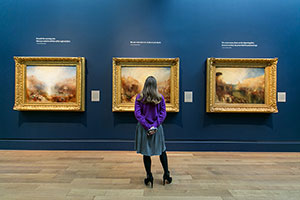
Open late May 23 and 24
The exhibition stays open till 9:00 p.m. for its final weekend, Saturday and Sunday, May 23 and 24, 2015.
Learn more
Mobile Tour

Pick up a multimedia player free of charge in the Museum Entrance Hall.
The multimedia tour is also available for your smartphone; bring your own headphones. Join GettyLink for free Wi-Fi during your visit.
Publication

J. M. W. Turner: Painting Set Free Edited by David Blayney Brown, Amy Concannon, and Sam Smiles

